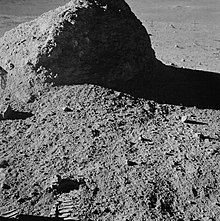Fillet (geology)
In planetary geology the term fillet describes a fine-grained deposit in an apron shape configuration that partially or entirely surround boulders on the surface of the Moon[1]. Fillets are a morphological expression of lunar soil development.

The fillet is characterized by an onlap contact with the adjacent rock and by a shallow or concave profile. Associated morphologies are thin pockets of dust present on top of the boulder and rock fragments either laying on top of, or buried by, the fillet. These rock fragments are chipped off from the original boulder by impacts of large meteoroids.
Origin
The preliminary scientific report of Apollo era[2] indicate that two processes, not mutually excluding, can be responsible for the development of fillets: 1) Deposition of material eroded from the boulder itself by the abrasive action of micrometeoroids, and 2) deposition of ejecta material from distant impact craters against the side of the boulder.

References
- "Apollo 11 Preliminary Science Report". www.hq.nasa.gov. Retrieved 2020-06-13.
- "Apollo 14 Preliminary Science Report". www.hq.nasa.gov. Retrieved 2020-06-13.